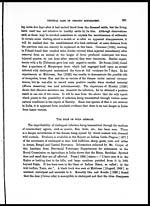Medicine - Veterinary > Veterinary colleges and laboratories > Indian journal of veterinary science and animal husbandry > Volume 2, 1932 > Original articles > Unusual case of chronic rinderpest with special reference to the carrier problem in this disease
(429) Page 362
Download files
Individual page:
Thumbnail gallery: Grid view | List view

362 THE INDIAN JOURNAL OF VETERINARY SCIENCE AND ANIMAL HUSBANDRY [II, IV
from the circulation within six days of recovery and Jacotot [ 1927 ] has also trans-
mitted rinderpest to a deer (Cervus aristotelis). It is a well-known fact that wild
buffaloes often mix freely at night with the herds of village buffaloes in certain
jungli tracts in India.
It is to be remembered that in South Africa the game was almost entirely
exterminated in the great rinderpest epizootic which raged among cattle during the
years 1896-1898. Hutchins [ 1915 ] incriminated game as a spreader of the disease
in Africa and pointed out that quarantine measures for the eradication of the disease
in such neighbourhoods is not wholly effective and he gave an example [ 1920 ] of
the appearance of cattle plague in certain parts of the Uganda Protectorate due to
the movement of rinderpest-infected game. Zonchello [ 1917 ] also incriminated
game as a factor in the spread of the disease and held that sero-vaccination should
not be practised in such areas, as the game was likely to take the disease from the
vaccinated animals and re-introduce the disease into populated land at a later
period. McCall [ 1920 ] implicated such game as bush buck, wild pig and eland in
the spread of rinderpest in Tanganyika. Edwards [ 1924 ] and Jacotot [ 1930,
1932 ] failed to demonstrate that the rabbit could become naturally infected, hence
the rôle of these and other rodents can be safely ignored. Inowe, Harade and Shi-
mazu [ 1930 ] proved that susliks (Citellus mangolicus ramosus, Thos.) are susceptible
to rinderpest and that occasionally these can become " virus carriers ", and their
experiments showed that blood from an inoculated suslik showing no symptoms may
be infective to cattle.
Although it sounds improbable Gilchrist [ 1848 ], from his personal experience
in the Madras Presidency, was of the opinion that the circumstance " of a tiger
having urined in the vicinity of the herd " of cattle can be productive of rinderpest.
When rinderpest gets freshly introduced into a country to which it is alien, the
danger of the spread of the disease to the wild game may be of paramount import-
ance. For, while it may be easy to eradicate the disease from the domestic animals
by an efficient veterinary police through registration of cattle, destruction of the
affected and enforcement of standstill orders, the uncontrolled movement of infected
game may render all these methods valueless. But in a country like India where
rinderpest has established a strong foothold and where the existence of numerous
extensive territories without any natural boundary renders the adoption of similar
methods impossible from political and other grounds, the importance of game as a
spreader of the infection may be said to be insignificant or unimportant. As will
be shown later, the factor that counts here most is the unsuspected cattle themsel-
ves and perhaps also some of the other domesticated animals which move among
cattle.
Set display mode to: Large image | Zoom image | Transcription
Images and transcriptions on this page, including medium image downloads, may be used under the Creative Commons Attribution 4.0 International Licence unless otherwise stated. ![]()
| Permanent URL | https://digital.nls.uk/75228539 |
|---|
| Description | Covers articles from 1932. |
|---|




